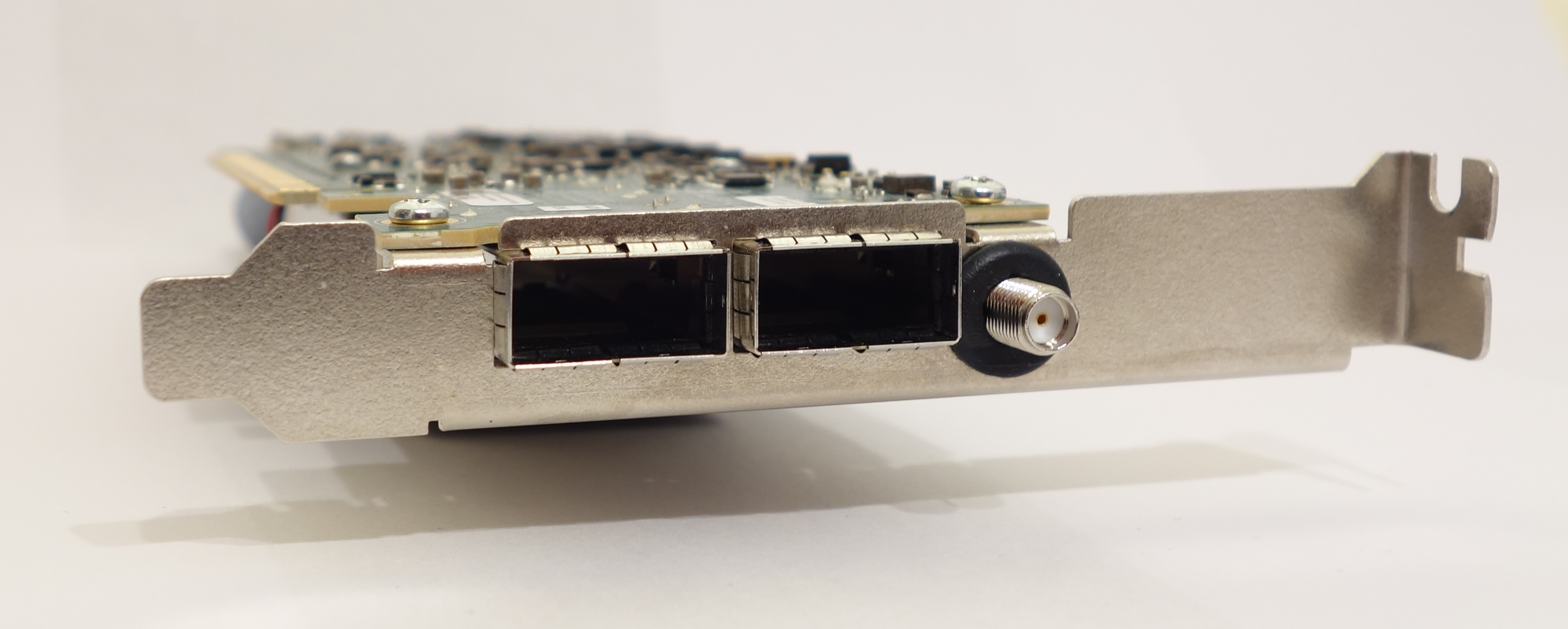STAR-Ultra PCIe Interface
The STAR-Ultra PCIe Interface is a SpaceFibre Multi-Lane interface and link analyser, designed to aid test and development of SpaceFibre equipment. It can transmit and receive SpaceFibre traffic from a host PC at data rates in excess of 10 Gbit/s in both directions simultaneously, and it can record and display SpaceFibre traffic transmitted and received on one SpaceFibre port.
The STAR-Ultra PCIe Interface is controlled by a host PC, connected by an eight-lane Gen 3 PCIe interface, and has two quad-lane SpaceFibre interfaces. Each lane can operate at a data signalling rate of up to 7.5 Gbit/s, resulting in a maximum link speed of 30 Gbit/s.
Graphical software is provided to easily configure, control and monitor the STAR-Ultra PCIe Interface. To transmit and receive SpaceFibre traffic to the SpaceFibre ports from the host PC, our software stack named STAR-System is used. This provides high-speed drivers, applications, APIs, examples and thorough documentation.
Separate link analysis software is used to capture and display SpaceFibre traffic. When a pre-defined trigger event is detected, SpaceFibre traffic is recorded to hardware memory. Once capture is complete, the traffic is uploaded to a host PC where it is interpreted and shown in multiple software views. Each view displays traffic in different levels of detail, allowing it to be inspected at network, packet, frame and word levels.
A similar product, named the STAR-Ultra PCIe Single-Lane Router, providing a SpaceFibre routing switch rather than an interface, is also available. A comparison of the functionality provided by the two products is shown below.
| Product | STAR-Ultra PCIe Interface | STAR-Ultra PCIe Single-Lane Router |
|---|---|---|
| Interface or Routing Switch | Interface | Routing Switch |
| Number of Ports | 2 | 8 |
| Lanes per Port | Up to 4 | 1 |
| Virtual Channels per Port | 8 | 8 |
| Lane Data Signalling Rate | 1, 1.25, 1.5, 1.875, 2, 2.5, 3, 3.125, 3.75, 5, 6, 6.25, 7.5 Gbit/s | 1, 1.25, 1.5, 1.875, 2, 2.5, 3, 3.125, 3.75, 4, 5, 6, 6.25 Gbit/s |
| Link Analysis | On port 1 | No |
| Software Channels | 16 | 18 |
Product Features
Two SpaceFibre quad-lane interfaces
- SpaceFibre lane data signalling rate is configurable (1, 1.25, 1.5, 1.875, 2, 2.5, 3, 3.125, 3.75, 5, 6, 6.25 and 7.5 Gbit/s)
- Each SpaceFibre interface has eight virtual channels
- Compatible with both single-lane and multi-lane far-end SpaceFibre interfaces with 1, 2, 4 or 8 lanes
- Hot redundancy support allows rapid switching to redundant lane in the event of a lane failure
- Lanes can be configured as unidirectional for asymmetric links
- QSFP connectors (multiple adaptors and cable assemblies available on request)
Transmit and receive SpaceFibre traffic
- Eight-lane Gen 3 PCIe interface to host PC allows software to transmit and receive SpaceFibre packets at high-speed (in excess of 10 Gbit/s on a typical PC)
- Transmit and receive broadcasts from host PC
Capture and display SpaceFibre traffic transmitted and received on SpaceFibre port 1
- Record over 178 million traffic items
- Capture SpaceFibre traffic to memory when specific symbols, words or errors are detected
- View captured SpaceFibre traffic in word, frame, packet and network level software views
- Remote Memory Access Protocol (RMAP) analysis displays the fields of packets conforming to the RMAP standard
- Search captured traffic for specific SpaceFibre words or for packets containing a particular data sequence
- Enable filtering for efficient memory usage
- Export captured traffic to CSV file for custom software to interpret
Contains 2 x SpaceFibre EGSE ports and 1 x eight-lane Gen 3 PCIe interface on a 16-lane connector
Software and accessories included:
- Windows drivers (Windows 11 and 10)
- Linux drivers (6.x, 5.x, 4.x and 3.x kernels)
- STAR-Ultra software: Controller, Statistics and Link Analyser applications
- STAR-System: Includes GUI applications and C, C++ and Python APIs with examples, for transmitting and receiving packets and broadcasts
- User manuals
- 1 year’s technical support and maintenance
Technical Specs
- Part Number
163
- Size
Half-length, low profile PCIe board with x16 connector. Both low-profile and full-height brackets provided.
174 x 68.9 x 32.5 mm
- Power
Supplied via PCIe connector
- SpaceFibre Ports
Compliant to ECSS-E-ST-50-11C
Number of SpaceFibre Ports: 2
Number of Virtual Channels per port: 8
Quad-lane interfaces compatible with single- and multi-lane far-end interfaces with 1, 2, 4 or 8 lanes
Configurable lane data signalling rate: 1, 1.25, 1.5, 1.875, 2, 2.5, 3, 3.125, 3.75, 5, 6, 6.25 and 7.5 Gbit/s
Hot and cold lane redundancy support
Asymmetric link support via configurable unidirectional lanes.
Connectors: QSFP+
- EMC
The STAR-Ultra PCIe Interface board is sold as a component for inclusion in a computer unit. EMC certification is the responsibility of the user.




